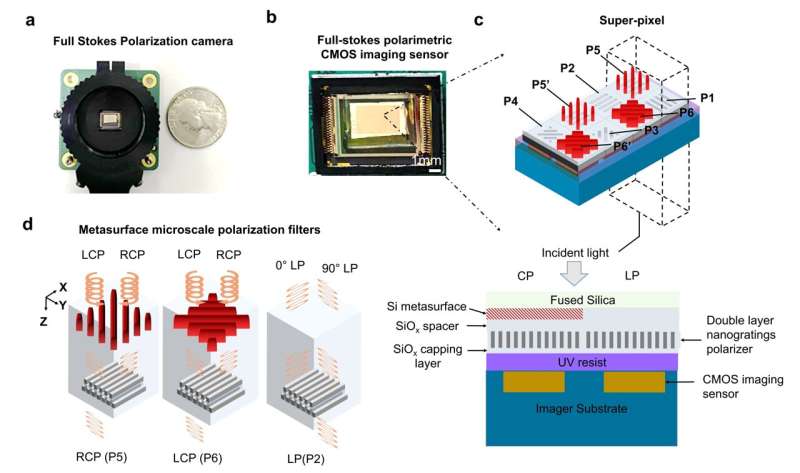This article has been reviewed according to Science X's editorial process and policies. Editors have highlighted the following attributes while ensuring the content's credibility:
fact-checked
peer-reviewed publication
trusted source
proofread
Unveiling the invisible: A bioinspired CMOS-integrated polarization imaging sensor

Polarimetric imaging can uncover features invisible to human eyes and conventional imaging sensors, and it is becoming an ever more essential technique in modern society. Conventional polarimetric imaging systems require complex optical components and moving parts, making system miniaturization difficult.
Recent development in optical metasurfaces and metamaterials show promising progress toward much more compact, flexible, and robust solutions for polarization detection than conventional techniques. However, current metasurface based polarimetric imaging devices suffer from issues in scalability, narrow bandwidth, low accuracy, and small field of view. So far, the demonstration of chip-integrated metasurface-based Full-Stokes polarimetric imaging sensors for visible wavelengths remains elusive.
In a new paper published in Light: Science & Applications, a team of scientists, led by Professor Yu Yao from Arizona State University, School of Electrical, Computer and Energy Engineering, and co-workers have developed chip-integrated metasurface-based Full-Stokes polarimetric imaging sensors for visible wavelengths inspired by the mantis shrimp eye.
They first designed metasurface-based, high optical performance microscale polarization filters including broadband linear polarization filters and dual-color (green and red) chiral metasurfaces. Based on these metasurface polarization filter designs, they fabricated a microscale polarization filters array (MPFA) composed of 75.2K filters, i.e., 75.2K pixels.
They then chip-integrated the MPFA onto the imaging sensor and calibrated the sensor polarization detection with the instrument matrix calibration method. With calibration, they achieved high polarization detection accuracy: Averaged polarization measurement error less than 2% for red (630nm to 670nm) and green color (480nm to 520nm).
Moreover, they found the polarimetric imaging sensor can maintain an error of less than 5% up to ±20° oblique incidence for red color and ±5° for green color. Finally, they demonstrated the full Stokes polarimetric imaging in real-life objects invisible to the traditional imaging sensor at red and green color with total operation bandwidth of 80nm.
From the polarization images of objects, they found polarization information carried by these objects are color-dependent, revealing the advantage of dual-wavelength operation. These scientists summarize the operational principle of their polarimetric imaging sensor:
"The metasurface polarimetric imager adopted the spatial division measurement approach to obtain full Stokes polarimetric images at one snapshot. Besides, the design of circular polarizer is inspired by the eye of mantis shrimp, who can see the polarization difference of light."
"We engineered artificial optical birefringence of Si metasurfaces working similar to a quarter waveplate with dual operation wavelengths range and stack it onto a double layered Al nanogratings with large linear polarization extinction ratio. We also found circular polarization extinction ratio of our chiral metasurface changes slowly to the oblique incidence angle, which is why our sensor can operate at a broad field of view with high detection accuracy."
"Overall, the metasurface polarimetric imaging sensor we developed is featured with high accuracy, large field of view, high speed (single-shot measurement), superior mechanical stability, ultra-compact footprint, fabrication scalability and CMOS compatibility." First author Jiawe Zuo added.
"Our demonstration proved a viable path to implement chip-integrated full-Stokes polarimetric imaging sensors at visible wavelengths based on metasurface device concepts, which could be widely applied in various real-world applications, such as autonomous vision, industrial inspection, space exploration, and biomedical imaging," the scientists said.
More information: Jiawei Zuo et al, Chip-integrated metasurface full-Stokes polarimetric imaging sensor, Light: Science & Applications (2023). DOI: 10.1038/s41377-023-01260-w
Journal information: Light: Science & Applications
Provided by Chinese Academy of Sciences




















